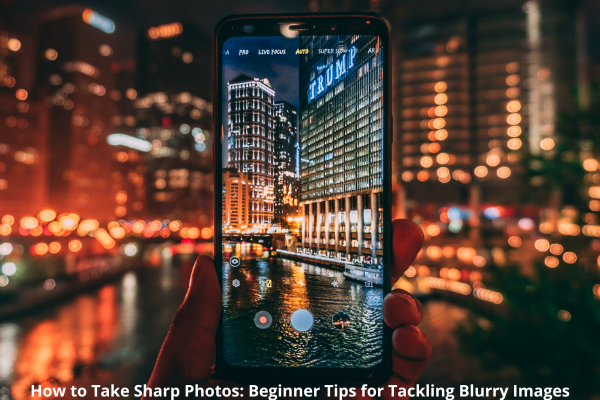One of the most frustrating problems for beginner photographers is ending up with blurry or soft photos. You press the shutter expecting a crisp shot, but instead, your image lacks detail or looks slightly out of focus.
The good news? Sharpness is completely within your control — and improving it doesn’t require expensive gear. In this guide, you’ll learn the most common causes of blurry photos and exactly how to fix them so your images look professional, clear, and crisp.
1. Understand What Causes Blurry Photos
Before you can fix the issue, you need to know why your photos aren’t sharp.
Most common reasons:
- Slow shutter speed = camera shake
- Incorrect focus = subject out of focus
- Motion blur = subject is moving too fast
- Dirty lens = smudges or dust on the glass
- Shallow depth of field = only a tiny part is in focus
Let’s break down how to solve each of these problems.
2. Use the Right Shutter Speed
The number one cause of blurry photos is using a shutter speed that’s too slow — especially when shooting handheld.
General rule:
- Keep your shutter speed at least 1 over your focal length
- For 50mm lens → use 1/60s or faster
- For 100mm lens → use 1/125s or faster
For moving subjects:
- People walking: 1/250s
- Sports or kids: 1/500s – 1/1000s
- Birds in flight or action: 1/2000s+
📌 When in doubt, use a faster shutter speed.
3. Stabilize Your Camera
Even with good settings, camera movement can cause blur. Keep your setup steady with these tips:
Solutions:
- Hold your camera with both hands, elbows tucked in
- Lean against a wall or table for extra stability
- Use a tripod or monopod for long exposures or telephoto shots
- Use the 2-second timer or remote shutter to avoid pressing the button directly
📱 For smartphones: rest your phone on a stable surface and use voice commands or a timer.
4. Use the Correct Focus Mode
Your focus settings determine whether the right part of your photo is sharp.
Focus Modes:
- Single-shot (AF-S / One Shot): Use for still subjects
- Continuous (AF-C / AI Servo): Use for moving subjects
- Manual Focus (MF): Use when you need precise control
📌 Tip: Use Single-Point Autofocus for precision. Place the focus point directly over the most important part of your subject.
5. Focus on the Right Spot
One of the most common beginner mistakes is focusing on the wrong part of the frame.
In portraits:
- Always focus on the eye closest to the camera — especially at wide apertures (f/1.8–f/2.8)
In landscapes:
- Use the hyperfocal distance — focus about one-third into the scene
📌 Take your time with focus — one slight error can ruin the entire shot.
6. Stop Down Your Aperture
Shooting with a very wide aperture (like f/1.4 or f/1.8) creates shallow depth of field — meaning only a small slice of your subject is in focus.
Try:
- f/2.8–f/4 for portraits with enough sharpness and blur
- f/5.6–f/11 for landscapes or group shots where more needs to be sharp
📌 At very small apertures (f/16+), watch for diffraction, which can slightly soften your image.
7. Clean Your Lens
Sometimes your photos are soft not because of technique — but because your lens is dirty.
Clean regularly with:
- Microfiber cloth
- Lens blower
- Lens cleaning solution (if needed)
📌 A smudge or fingerprint can make your photo look foggy or hazy.
8. Use Image Stabilization (If Available)
Many cameras and lenses have built-in stabilization (IS, VR, OIS, IBIS). It helps reduce shake at slower shutter speeds.
When to use it:
- Handheld shooting in low light
- Video recording
- Telephoto or zoom lenses
📌 Turn it off when using a tripod, as it can cause micro-movements.
9. Shoot in Good Light
Low light makes it harder to get sharp photos because your camera:
- Uses slower shutter speeds
- Struggles with focus
Solutions:
- Shoot in daylight or near windows
- Use additional lighting indoors
- Raise your ISO if needed — better a sharp photo with noise than a blurry clean one
10. Use Burst Mode for Moving Subjects
If your subject is moving (kids, pets, sports), shoot in burst mode to increase your chances of getting one perfectly sharp image.
📌 Tip: Combine burst mode with continuous autofocus to track motion.
11. Zoom In to Check Sharpness
After taking a photo, always zoom in on your camera screen to check:
- Is the focus accurate?
- Are the eyes sharp in portraits?
- Is there motion blur?
Don’t rely on the small thumbnail — what looks fine at a glance might be soft when viewed full-size.
12. Edit for Maximum Sharpness (But Don’t Overdo It)
Most images benefit from a little sharpening in post-processing.
Use tools in:
- Lightroom: Detail > Sharpening + Masking
- Photoshop: Unsharp Mask, High Pass Filter
- Snapseed (mobile): Details > Structure & Sharpening
📌 Don’t oversharpen — it creates halos and noise. Aim for natural clarity.
Final Thoughts: Sharpness Comes From Technique, Not Gear
You don’t need an expensive lens or the latest camera to take sharp photos. What you need is:
- The right settings
- A stable shooting position
- An understanding of focus and depth
Start applying the tips above, and you’ll immediately notice your photos look crisper, cleaner, and more professional — no upgrade required.
